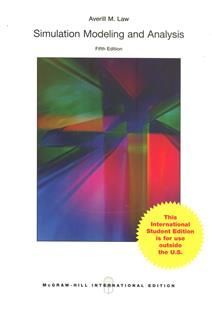Simulation Modeling and Analysis 5/e
- 滿20件,享8.5折
售價
$
1,150
- 一般書籍
- ISBN:9781259254383
- 作者:Averill Law
- 版次:5
- 年份:2015
- 出版商:McGraw-Hill
- 頁數/規格:776頁/平裝單色
書籍介紹
本書特色
目錄
Description
Since the publication of the first edition in 1982, the goal of Simulation Modeling and Analysis has always been to provide a comprehensive, state-of-the-art, and technically correct treatment of all important aspects of a simulation study. The book strives to make this material understandable by the use of intuition and numerous figures, examples, and problems. It is equally well suited for use in university courses, simulation practice, and self study. The book is widely regarded as the a€œbiblea€ of simulation and now has more than 100,000 copies in print. The book can serve as the primary text for a variety of courses; for example:
Since the publication of the first edition in 1982, the goal of Simulation Modeling and Analysis has always been to provide a comprehensive, state-of-the-art, and technically correct treatment of all important aspects of a simulation study. The book strives to make this material understandable by the use of intuition and numerous figures, examples, and problems. It is equally well suited for use in university courses, simulation practice, and self study. The book is widely regarded as the a€œbiblea€ of simulation and now has more than 100,000 copies in print. The book can serve as the primary text for a variety of courses; for example:
- A first course in simulation at the junior, senior, or beginning-graduate-student level in engineering, manufacturing, business, or computer science (Chaps. 1 through 4, and parts of Chaps. 5 through 9). At the end of such a course, the students will be prepared to carry out complete and effective simulation studies, and to take advanced simulation courses.
- A second course in simulation for graduate students in any of the above disciplines (most of Chaps. 5 through 12). After completing this course, the student should be familiar with the more advanced methodological issues involved in a simulation study, and should be prepared to understand and conduct simulation research.
- An introduction to simulation as part of a general course in operations research or management science (part of Chaps. 1, 3, 5, 6, and 9).
Features
- A CD-ROM containing the Student Version of the ExpertFit distribution-fitting software will be included and will tie to the book
- Up-to-date treatment of the latest simulation software, including a common example in four of the leading products
- All of the software used in the book has been upgraded to FORTRAN and C.
- 20% new problems and examples
- More comprehensive and practical discussion of how to validate a simulation model
- New and improved random-number generators
- Latest statistical techniques for estimating the performance measures of a simulated system, both for terminating and steady-state simulations
- Ranking-and-selection procedures for choosing the best system configuration, which allow the use of common random numbers for increased efficiency
- More detailed discussion of how to use the method of common random numbers in practice
- Greatly expanded and self-contained discussion of classical design of experiments, with a particular emphasis on how to correctly implement these techniques in the context of simulation modeling
- Several detailed examples on the use of simulation-based optimization
Table of Contents
1 Basic Simulation Modeling
2 Modeling Complex Systems
3 Simulation Software
4 Review of Basic Probability and Statistics
5 Building Valid, Credible, and Appropriately Detailed Simulation Models
6 Selecting Input Probability Distributions
7 Random-Number Generators
8 Generating Random Variates
9 Output Data Analysis for a Single System
10 Comparing Alternative System Configurations
11 Variance-Reduction Techniques
12 Experimental Design, Sensitivity Analysis, and Optimization
13 Agent-Based Simulation and System Dynamics
14 Simulation of Manufacturing Systems
1 Basic Simulation Modeling
2 Modeling Complex Systems
3 Simulation Software
4 Review of Basic Probability and Statistics
5 Building Valid, Credible, and Appropriately Detailed Simulation Models
6 Selecting Input Probability Distributions
7 Random-Number Generators
8 Generating Random Variates
9 Output Data Analysis for a Single System
10 Comparing Alternative System Configurations
11 Variance-Reduction Techniques
12 Experimental Design, Sensitivity Analysis, and Optimization
13 Agent-Based Simulation and System Dynamics
14 Simulation of Manufacturing Systems

